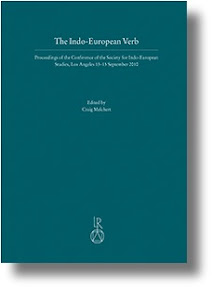Inhalt
Foreword. vii
BENEDETTI, Marina:
Valency Alternations with Perception Verbs in Indo-European Languages. 1
BOZZONE, Chiara:
The PIE Subjunctive: Function and Development. 7
DAHL, Eystein:
Towards an Account of the Semantics of the PIE Imperative. 19
DAUES, Alexandra:
Hittite Verbs in -ssa-: Can a Function Be Recognized? 29
Di GIOVINE, Paolo:
The Function of *o-Ablaut in the PIE Verbal System. 43
ESKA, Joseph F.:
Absolute and Conjunct, Cowgill and Apocope. 51
GARCIA CASTILLERO, Carlos:
The Old Irish Paradigm of Clause Types. 61
GARCÍA RAMÓN, José Luis:
Aspect and Mood in Indo-European Reconstruction. 73
HACKSTEIN, Olav:
When Words Coalesce: Chunking and Morphophonemic Extension. 87
HILL, Eugen, and Michael FROTSCHER:
The Accentuation of Old Indic Reduplicated (3rd Class) Presents. 105
HOCK, Hans Henrich:
Phrasal Prosody and the Indo-European Verb. 115
JASANOFF, Jay H.:
Long-vowel Preterites in Indo-European. 127
KIM, Ronald I.:
Unus testis, unicus testis? The Ablaut of Root Aorists in Tocharian and Indo-European. 137
KLOEKHORST, Alwin:
Hittite "ā/e"-ablauting Verbs. 151
KOCHAROV, Petr:
Perfect Reduplication in Late Indo-European. 161
KÖLLIGAN, Daniel:
Patterns of Suppletion in Classical Armenian: The Case of Motion Verbs. 167
KRASUKHIN, Konstantin G.:
Indo-European Conjugation: History and Pre-History. 179
KROONEN, Guus:
Reflections on the 0/zero-Ablaut in the Germanic Iterative Verbs. 191
KÜMMEL, Martin Joachim:
The Inflection of the Hittite Verb Class of mema/i-. 201
LEHNERT, Christian:
Anmerkungen zum homerischen Augment. 209
LÜHR, Rosemarie:
Ereignistyp und Diathesenwechsel im Indogermanischen. 213
MAJER, Marek:
An Archaic Indo-European Verbal Form in the Slavic Generalizing Particle *-žīdo? 225
MALZAHN, Melanie:
Archaism and Innovation in the Tocharian Verbal System: The Case of Valency and the Case for a Conspiracy Theory. 235
OETTINGER, Norbert:
Das Verhaltnis von nominaler und verbaler Reduplikation im Indogermanischen und Anatolischen. 241
PEYROT, Michaël:
e-grade in Tocharian Verbal Morphology. 247
PINAULT, Georges-Jean:
Interpretation of the Tocharian Subjunctive of Class III. 257
POOTH, Roland A.:
Zum Aufkommen transitiver Verben im fruhen Vedischen am Beispiel √ṛ. 267
RASMUSSEN, Jens E.:
The Origin of the Albanian Mediopassive. 285
REINHART, Johannes:
Inheritance or Innovation in the Proto-Slavic Verb: the Ending -mo (1st Person Plural). 289
SCHEUNGRABER, Corinna:
Nasal Suffix Verbs in Germanic and Kluge's Law. 295
SOWA, Wojciech:
The Phrygian Middle. 305
DE VAAN, Michiel:
Latin Deverbal Presents in -ā-. 315
VLLLANUEVA SVENSSON, Miguel:
The Ablaut of the Middle Root Athematic Presents in Indo-European. 333
YOSHIDA, Kazuhiko:
Notes on Cuneiform Luvian Verbs in *-ye/o-. 343
ZlEGLER, Sabine:
Zur Konzeption moderner Worterbücher: Probleme der Philologie und der Lexikographie dargestellt anhand der uridg. Wurzeln *h1eish2- "antreiben", *h2eis- "suchen" und ihrer Fortsetzer im rigvedischen Sanskrit. 353
Contact Information of Contributors. 365
Melchert: The Indo-European Verb, 2012

